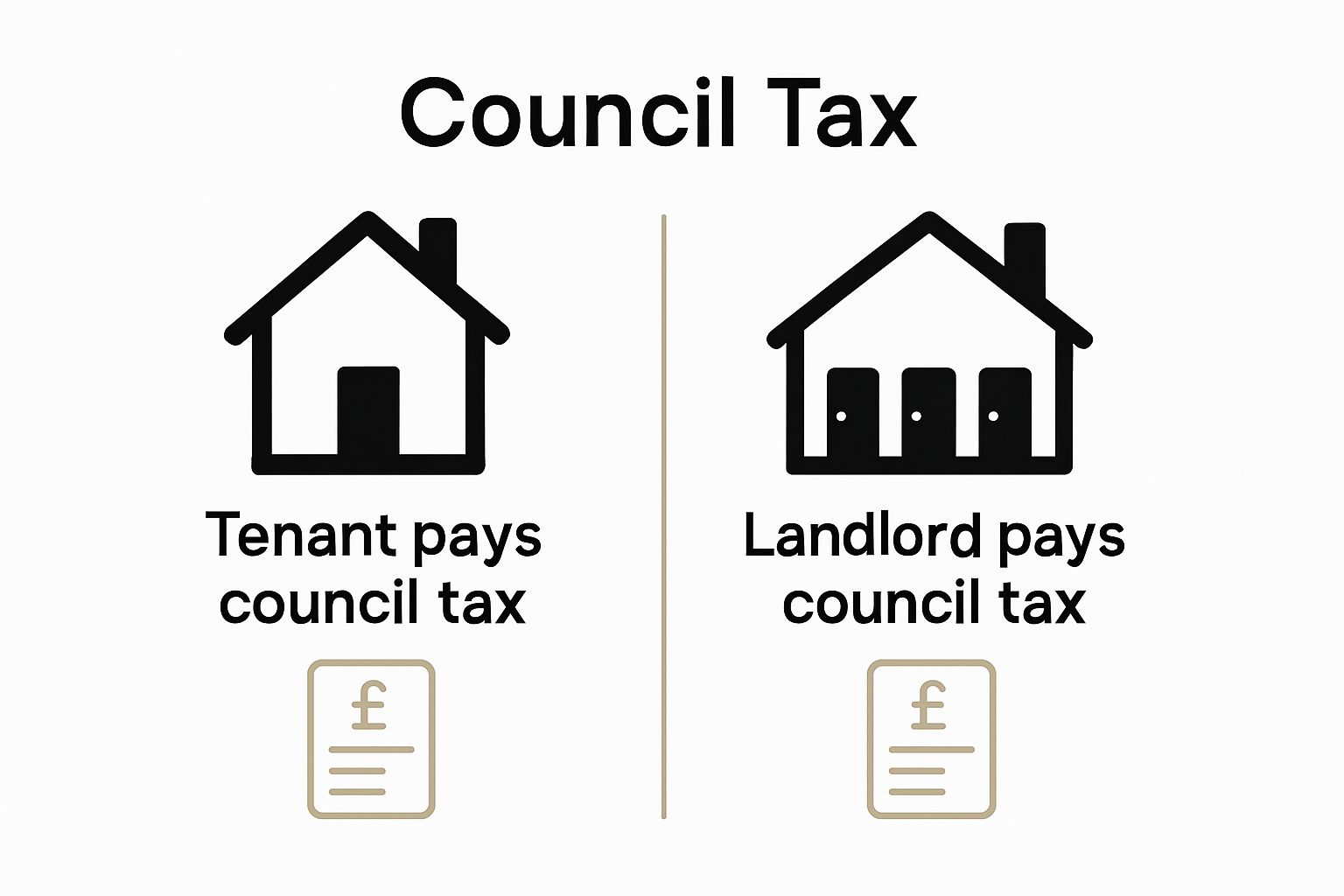Council tax on Houses in Multiple Occupation trips up plenty of UK property investors. Most expect tenants to cover the bill, yet in over 90 percent of HMOs the landlord shoulders the full council tax responsibility. This flips budgeting upside down and shifts legal risk in ways that surprise even experienced landlords.
Quick Summary
| Takeaway | Explanation |
|---|---|
| Council Tax Liability Generally Falls on Landlords | In HMOs, landlords usually bear the responsibility for council tax payments, simplifying tax management. |
| Understanding Tax Calculation is Essential | Council tax for HMOs is based on property size, valuation, and number of occupants, which affects financial obligations. |
| Compliance with Legal Obligations is Crucial | Landlords must ensure accurate property classification, timely payments, and maintain documentation to avoid legal issues. |
| Tenants Should Be Aware of Tax Responsibilities | While landlords manage council tax, tenants may face liability in specific circumstances outlined in tenancy agreements. |
| Robust Financial Planning is Key for Landlords | Proper integration of council tax into investment calculations helps manage expenses and avoid unexpected financial burdens. |
Defining Council Tax HMO and Its Purpose
Council Tax HMO represents a specific taxation approach for Houses in Multiple Occupation (HMO) within the UK property landscape. Unlike standard residential properties, HMOs have unique council tax considerations that impact both landlords and tenants. Understanding what is council tax HMO involves recognizing the nuanced legal framework surrounding property taxation in multi-tenant environments.
Legal Framework and Liability
Under the Local Government Finance Act 1992, council tax liability in HMOs can differ significantly from traditional single-occupancy properties. In most scenarios, the property owner or landlord becomes responsible for council tax payments rather than individual tenants.
 This approach ensures consistent tax collection and reduces administrative complexities associated with tracking multiple tenant contributions.
This approach ensures consistent tax collection and reduces administrative complexities associated with tracking multiple tenant contributions.
Determining Tax Responsibility
Council tax for HMOs is calculated based on several critical factors:
- Property size and total number of occupants
- Property valuation and tax band classification
- Number of rooms and shared living spaces
- Total property rental income
The tax calculation considers the property as a single residential unit, with the landlord typically managing the entire council tax payment. This method simplifies tax collection and provides a more streamlined approach to property taxation in multi-tenant scenarios.
By understanding these intricate details, property investors and landlords can better navigate the financial obligations associated with HMO properties and ensure compliance with local taxation regulations.
The Importance of Understanding Council Tax HMO
Understanding council tax for Houses in Multiple Occupation (HMO) goes beyond mere compliance it is a critical aspect of successful property investment and management. Navigating HMO legal requirements involves comprehensive knowledge of taxation implications that directly impact financial performance and operational efficiency.
Financial Management and Investment Strategy
Council tax in HMOs represents a significant operational expense that can substantially influence an investor’s bottom line. Property owners must recognize that incorrect tax calculations or misunderstandings about liability can lead to unexpected financial burdens. According to HM Revenue & Customs, precise tax reporting and payment are mandatory, with potential penalties for non-compliance.
Compliance and Legal Obligations
The implications of mismanaging council tax in HMO properties extend beyond financial considerations. Landlords must understand their legal responsibilities to avoid potential legal challenges. Key compliance considerations include:
- Accurate property classification
- Timely tax payments
- Proper tenant communication regarding tax responsibilities
- Maintaining comprehensive documentation
Professional investors recognize that thorough understanding of council tax regulations helps mitigate risks and ensures smooth property management. Proactive approach to tax management can prevent costly mistakes and potential disputes with local authorities.
By developing a comprehensive understanding of council tax HMO, property investors can make informed decisions, optimize their investment strategies, and maintain legal and financial integrity in their property portfolios.
How Council Tax HMO Works in Practice
Council tax in HMO properties involves a complex process that requires precise understanding and strategic management. Understanding HMO property management becomes crucial for landlords seeking to navigate the intricate taxation landscape effectively.
Property Classification and Tax Determination
In practical terms, council tax for HMOs is determined by several interconnected factors. Local Government Finance Act regulations mandate that properties be classified according to specific criteria that influence tax calculations. The property’s valuation band, total number of occupants, and specific usage characteristics play critical roles in establishing the precise tax liability.
Liability and Payment Mechanisms
Council tax responsibility in HMO scenarios typically falls on the landlord when tenants rent individual rooms within a shared living environment. Key practical considerations include:
- Identifying the primary liable party (usually the landlord)
- Calculating tax based on the entire property’s characteristics
- Determining appropriate tax band classification
- Managing payment schedules and potential exemptions
The practical implementation requires landlords to maintain meticulous records and communicate transparently with local authorities. Successful HMO council tax management demands a proactive approach that anticipates potential administrative complexities and ensures full regulatory compliance.
By understanding these practical mechanisms, property investors can transform council tax from a potential administrative burden into a manageable aspect of their investment strategy, minimizing financial risks and maintaining smooth operational processes.
This table outlines the main factors that influence council tax calculations for HMO properties, providing a rapid reference for investors and property owners.
| Factor | How It Affects Council Tax in HMOs | Notes |
|---|---|---|
| Property size and floor area | Determines valuation band and total tax amount | Larger properties often attract higher council tax |
| Number of rooms and occupants | May influence assessment of single vs. multiple units | Affects tax band classification and liability |
| Property valuation (as of April 1991) | Sets the base tax band for council tax purposes | Performed by the Valuation Office Agency |
| Rental income potential | Sometimes considered in property valuation | Reflects market value for classification |
| Shared vs. self-contained facilities | Defines whether whole property or individual units are assessed | Critical for liability and banding |
Key Concepts Related to Council Tax HMO
Council tax HMO involves intricate legal and financial principles that demand comprehensive understanding from property investors. Understanding HMO regulations becomes essential for navigating the complex landscape of property taxation and management.
Tax Band and Valuation Principles
The fundamental concept of council tax in HMO properties revolves around property valuation and classification. According to The Valuation Office Agency, properties are assigned specific tax bands based on their assessed market value as of 1 April 1991. For HMO properties, this valuation considers the entire property’s characteristics, including:
- Total floor area
- Number of rooms
- Property location
- Potential rental income
- Structural configurations
Legal Liability and Regulatory Framework
The legal framework governing council tax in HMOs extends beyond simple monetary transactions. Landlords must understand the nuanced responsibilities that define tax obligations. The primary legal considerations include distinguishing between different property occupancy models and recognizing the specific circumstances that determine tax liability.
Ultimately, successful management of council tax in HMO properties requires a strategic approach that balances financial planning, legal compliance, and thorough understanding of regulatory requirements. Property investors who develop a robust comprehension of these key concepts can effectively minimize potential tax complications and optimize their investment strategies.
Implications for Tenants and Landlords
Council tax HMO introduces complex dynamics that significantly impact both tenants and landlords, requiring nuanced understanding of financial and legal responsibilities. 8 Essential Tips for Your HMO Legal Checklist provides critical insights into managing these intricate relationships.
Tenant Responsibilities and Rights
In HMO scenarios, tenants must comprehend their position regarding council tax obligations. According to Citizens Advice, while landlords typically handle council tax for HMO properties, tenants should understand potential scenarios where they might become liable:
- Properties where individual tenants are named on the council tax bill
- Situations involving complex rental agreements
- Specific contractual arrangements outlined in tenancy documents
- Potential partial liability in unique occupancy configurations
Landlord Financial and Legal Considerations
Landlords bear primary responsibility for council tax management in most HMO scenarios. This involves strategic financial planning and comprehensive understanding of potential implications. Key considerations include:
- Integrating council tax costs into overall property investment calculations
- Understanding potential tax band reassessments
- Maintaining transparent communication with local authorities
- Developing robust accounting practices for tax management
Successful navigation of council tax HMO requires proactive engagement, clear communication, and thorough understanding of legal frameworks. Both tenants and landlords must approach these responsibilities with diligence and informed strategy to ensure smooth property management and financial compliance.
The table below compares the key responsibilities and implications of council tax for both HMO landlords and tenants, clarifying how each party may be affected in different scenarios.
| Role | Primary Council Tax Responsibility | Typical Scenarios of Liability | Key Considerations |
|---|---|---|---|
| Landlord | Usually liable | When letting individual rooms in a shared HMO | Must budget for council tax, ensure classification, comply with legal obligations |
| Tenant | Occasionally liable | If named on council tax bill; special tenancy agreement | Must review tenancy contract and clarify liability with landlord |
| Both | Partial/shared liability | Complex agreements or unique occupancy arrangements | Open communication, clear documentation, seek advice where needed |

Tackle HMO Council Tax with Expert Tools and Support
Struggling to grasp the complexities of council tax for HMO properties can leave you feeling overwhelmed and uncertain. Whether you are a landlord wanting to avoid costly mistakes or an investor looking to streamline your finances, tackling these unique tax challenges is essential for your financial health and compliance. The article has highlighted how intricate issues like liability, property classification, and legal obligations can directly impact your investment success and peace of mind.
Now is the perfect time to take control and simplify every aspect of HMO property management. Access the UK’s leading HMO marketplace at agenthmo.co.uk, where you will find professional guidance, support for compliance, property valuation tools, and a trusted network of service providers tailored specifically to Houses in Multiple Occupation. Ready to resolve your council tax worries and optimise your HMO investment? Visit agenthmo.co.uk today and explore solutions designed precisely for your needs.
Frequently Asked Questions
What is Council Tax HMO?
Council Tax HMO refers to the taxation framework applied to Houses in Multiple Occupation (HMO). It primarily assigns council tax responsibility to landlords instead of individual tenants, simplifying tax management across multiple tenants.
Who is liable for Council Tax in an HMO?
In most cases, the landlord is responsible for the Council Tax on HMO properties. To ensure compliance, confirm your property classification and understand your obligations regarding tax payments and tenant communications.
How is Council Tax HMO calculated?
Council Tax for HMOs is calculated based on the property’s valuation band, number of occupants, and number of rooms. Review your property’s specifics to ensure accurate tax payments and avoid unexpected liabilities.
What should landlords do to comply with Council Tax HMO regulations?
Landlords should maintain accurate property classifications, ensure timely tax payments, and communicate tax responsibilities clearly to tenants. Regularly assess your property against local council regulations to stay compliant and avoid penalties.
How can tenants check their potential Council Tax responsibilities in an HMO?
Tenants can review their rental agreements to understand if they hold any liability for Council Tax. Conduct a thorough examination of your tenancy conditions and clarify any concerns with your landlord to ensure transparency in financial obligations.
Why is understanding Council Tax HMO important for property investors?
Understanding Council Tax HMO is crucial as it impacts both financial performance and operational efficiency. Familiarise yourself with tax regulations to optimise your investment strategy and reduce risks associated with tax mismanagement.



